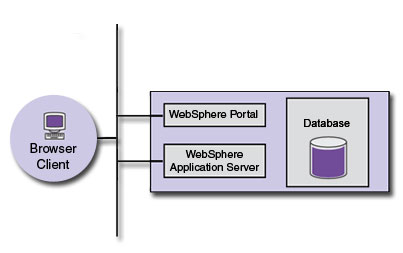Single-server topology
A single instance of WebSphere Portal provides a fully functional appserver and a web site that is capable of serving a medium to small user community. Initially, a single instance is configured to use an internal database based on Derby that is unsuitable for production use and must be replaced by an enterprise class database.
Singer server deployments are ideal for development, test, demonstration and education, and, as mentioned, some small production sites. A single server, however, presents a single point of failure and must be converted to a cluster or server farm to improve its capacity, availability, and ability to recover from failure conditions.
A Web server configured with IBM WAS's HTTP plug-in will front a typical server deployment for test or production use. The Web server provides the ability to serve static resources, such as images and style sheets, as well as a plug-in point for a corporate single sign-on (SSO) agent, in the event that WebSphere Portal will participate in a global SSO domain.
The following illustration displays a common topology for a single server environment. Only one server is needed. WebSphere Portal, WAS, and the database are all installed on the same server.

Parent topic:
Server topologiesRelated concepts
Stand-alone server topology
Horizontal cluster topology
Vertical cluster topology
Combination of horizontal and vertical clusters
Multiple clusters
Single-server topology for Web Content Management
Dual-server configuration for Web Content Management
Staging-server topology for Web Content Management